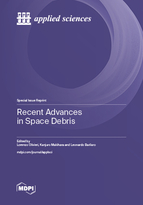Recent Advances in Space Debris
A special issue of Applied Sciences (ISSN 2076-3417). This special issue belongs to the section "Aerospace Science and Engineering".
Deadline for manuscript submissions: closed (31 May 2023) | Viewed by 15567
Special Issue Editors
Interests: space debris; small satellites; active debris removal; docking
Interests: space debris impact; tether system; electrodynamic tether; removal method
Special Issue Information
Dear Colleagues,
Space debris represents a risk for current and future missions in Earth orbit. Debris impacts may cause damages to space vehicles up to the point of loss of functionality of the entire spacecraft. The debris environment therefore requires continuous monitoring and regulation strategies, which should be coordinated among all stakeholders to avoid any further deterioration.
This Special Issue aims to present recent advances in research on space debris to improve the safety of the near-Earth orbits and mitigate the risks related to debris impacts. Topics of interest include but are not limited to hypervelocity impact modeling and testing; spacecraft vulnerability analysis and protection design and development; debris observation and environmental modeling; fragmentation event simulation, analysis, and observation; re-entry technologies and life-extension systems; active debris removal concepts, missions, and in-orbit demonstrations; sensors and systems for disposal; and space traffic management.
Dr. Lorenzo Olivieri
Prof. Dr. Kanjuro Makihara
Dr. Leonardo Barilaro
Guest Editors
Manuscript Submission Information
Manuscripts should be submitted online at www.mdpi.com by registering and logging in to this website. Once you are registered, click here to go to the submission form. Manuscripts can be submitted until the deadline. All submissions that pass pre-check are peer-reviewed. Accepted papers will be published continuously in the journal (as soon as accepted) and will be listed together on the special issue website. Research articles, review articles as well as short communications are invited. For planned papers, a title and short abstract (about 100 words) can be sent to the Editorial Office for announcement on this website.
Submitted manuscripts should not have been published previously, nor be under consideration for publication elsewhere (except conference proceedings papers). All manuscripts are thoroughly refereed through a single-blind peer-review process. A guide for authors and other relevant information for submission of manuscripts is available on the Instructions for Authors page. Applied Sciences is an international peer-reviewed open access semimonthly journal published by MDPI.
Please visit the Instructions for Authors page before submitting a manuscript. The Article Processing Charge (APC) for publication in this open access journal is 2400 CHF (Swiss Francs). Submitted papers should be well formatted and use good English. Authors may use MDPI's English editing service prior to publication or during author revisions.







